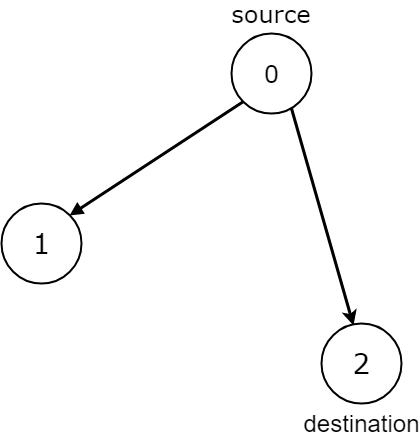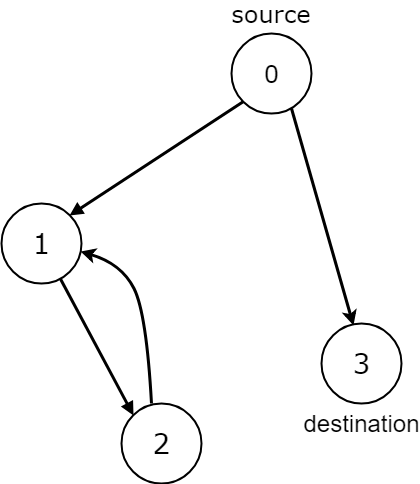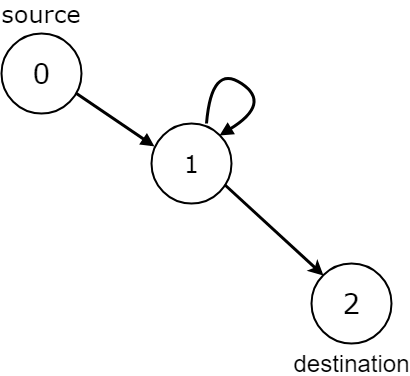Given the edges of a directed graph, and two nodes source and destination of this graph, determine whether or not all paths starting from source eventually end at destination, that is:
- At least one path exists from the
sourcenode to thedestinationnode - If a path exists from the
sourcenode to a node with no outgoing edges, then that node is equal todestination. - The number of possible paths from
sourcetodestinationis a finite number.
Return true if and only if all roads from source lead to destination.
Example 1:

Input: n = 3, edges = [[0,1],[0,2]], source = 0, destination = 2
Output: false
Explanation: It is possible to reach and get stuck on both node 1 and node 2.
Example 2:

Input: n = 4, edges = [[0,1],[0,3],[1,2],[2,1]], source = 0, destination = 3
Output: false
Explanation: We have two possibilities: to end at node 3, or to loop over node 1 and node 2 indefinitely.
Example 3:

Input: n = 4, edges = [[0,1],[0,2],[1,3],[2,3]], source = 0, destination = 3
Output: true
Example 4:

Input: n = 3, edges = [[0,1],[1,1],[1,2]], source = 0, destination = 2
Output: false
Explanation: All paths from the source node end at the destination node, but there are an infinite number of paths,
such as 0-1-2, 0-1-1-2, 0-1-1-1-2, 0-1-1-1-1-2, and so on.
Example 5:

Input: n = 2, edges = [[0,1],[1,1]], source = 0, destination = 1
Output: false
Explanation: There is infinite self-loop at destination node.
Note:
- The given graph may have self loops and parallel edges.
- The number of nodes
nin the graph is between1and10000 - The number of edges in the graph is between
0and10000 0 <= edges.length <= 10000edges[i].length == 20 <= source <= n - 10 <= destination <= n - 1
从始点到终点的所有路径。
给定有向图的边 edges,以及该图的始点 source 和目标终点 destination,确定从始点 source 出发的所有路径是否最终结束于目标终点 destination,即:
- 从始点 source 到目标终点 destination 存在至少一条路径
- 如果存在从始点 source 到没有出边的节点的路径,则该节点就是路径终点。
- 从始点source到目标终点 destination 可能路径数是有限数字
- 当从始点 source 出发的所有路径都可以到达目标终点 destination 时返回 true,否则返回 false。
来源:力扣(LeetCode)
链接:https://leetcode-cn.com/problems/all-paths-from-source-lead-to-destination
著作权归领扣网络所有。商业转载请联系官方授权,非商业转载请注明出处。
这是一道有向图的题。题目的意思解释的很清楚,给了起点,终点,所有的边,请你判断是不是所有从起点开始的边都能带你去到终点。
遇到图的题,绝大部分还是先创建图,再用DFS或者BFS去遍历。这个题需要注意的点是
- 当遇到一个终点(这个点没有next节点),判断这个点是不是 destination
- hashmap的做法是判断这个点在 hashmap 里是否能找到,如果找不到,就判断他不是destination;或者说这条路径不在起点 - 终点的路径上
- 判断图中是否有环 - 用hashset判断是否访问过或者用染色法
- 当遍历当前点的邻居们的时候,如果发现任何一个邻居已经在 hashset 存在了,则发现了环,return false。
- 判断环是因为如果有环的话那说明一定有某条路径不在起点 - 终点的路径上
思路不难想,代码的实现需要多练,面试才会写的6。
时间O(V + E)
空间O(V + E)
Java实现 - hashmap建图
1 class Solution { 2 public boolean leadsToDestination(int n, int[][] edges, int source, int destination) { 3 // build the graph 4 HashMap<Integer, List<Integer>> graph = new HashMap<>(); 5 for (int[] edge : edges) { 6 graph.putIfAbsent(edge[0], new ArrayList<>()); 7 graph.get(edge[0]).add(edge[1]); 8 } 9 return helper(graph, new HashSet<>(), source, destination); 10 } 11 12 private boolean helper(Map<Integer, List<Integer>> graph, Set<Integer> visited, int cur, int end) { 13 // base case 14 if (!graph.containsKey(cur)) { 15 return cur == end; 16 } 17 visited.add(cur); 18 for (int neighbor : graph.get(cur)) { 19 if (visited.contains(neighbor) || !helper(graph, visited, neighbor, end)) { 20 return false; 21 } 22 } 23 visited.remove(cur); 24 return true; 25 } 26 }
Java实现 - list建图
1 class Solution { 2 public boolean leadsToDestination(int n, int[][] edges, int source, int destination) { 3 List<Integer>[] graph = new List[n]; 4 int[] colors = new int[n]; 5 buildGraph(graph, edges); 6 return helper(graph, source, destination, colors); 7 } 8 9 private void buildGraph(List<Integer>[] graph, int[][] edges) { 10 for (int[] edge : edges) { 11 int from = edge[0]; 12 int to = edge[1]; 13 if (graph[from] == null) { 14 graph[from] = new LinkedList<>(); 15 } 16 graph[from].add(to); 17 } 18 } 19 20 private boolean helper(List<Integer>[] graph, int source, int destination, int[] colors) { 21 // base case 22 if (graph[source] == null || graph[source].size() == 0) { 23 return source == destination; 24 } 25 colors[source] = 1; 26 for (int next : graph[source]) { 27 // if visited 28 if (colors[next] == 1) { 29 return false; 30 } 31 if (colors[next] == 0 && !helper(graph, next, destination, colors)) { 32 return false; 33 } 34 colors[source] = 0; 35 } 36 return true; 37 } 38 }